Preschool Learning: Rainbow Wizard Brew Experience Plan for Kids
VerifiedAdded on 2022/10/17
|5
|1330
|7
Practical Assignment
AI Summary
This assignment presents a detailed experience plan designed for preschool children aged 4-5, centered around a Rainbow Wizard Brew activity. The plan outlines the title of the experience, which involves children creating a bubbling "wizard's brew" using baking soda, glitter, dish soap, vinegar, and edible colors in a glass jar. The setup includes a tray to contain the reaction and ensure proper visibility. The rationale connects the activity to the development of scientific skills, problem-solving, and communication. The plan aligns with EYLF principles, focusing on secure, respectful, and reciprocal relationships. It identifies specific developmental learning outcomes, such as enhancing scientific understanding and problem-solving abilities. Teaching strategies include showing videos, asking open-ended questions, praising children, and providing different amounts of materials to explore the effects of varying quantities. References to relevant research are included to support the pedagogical approach.
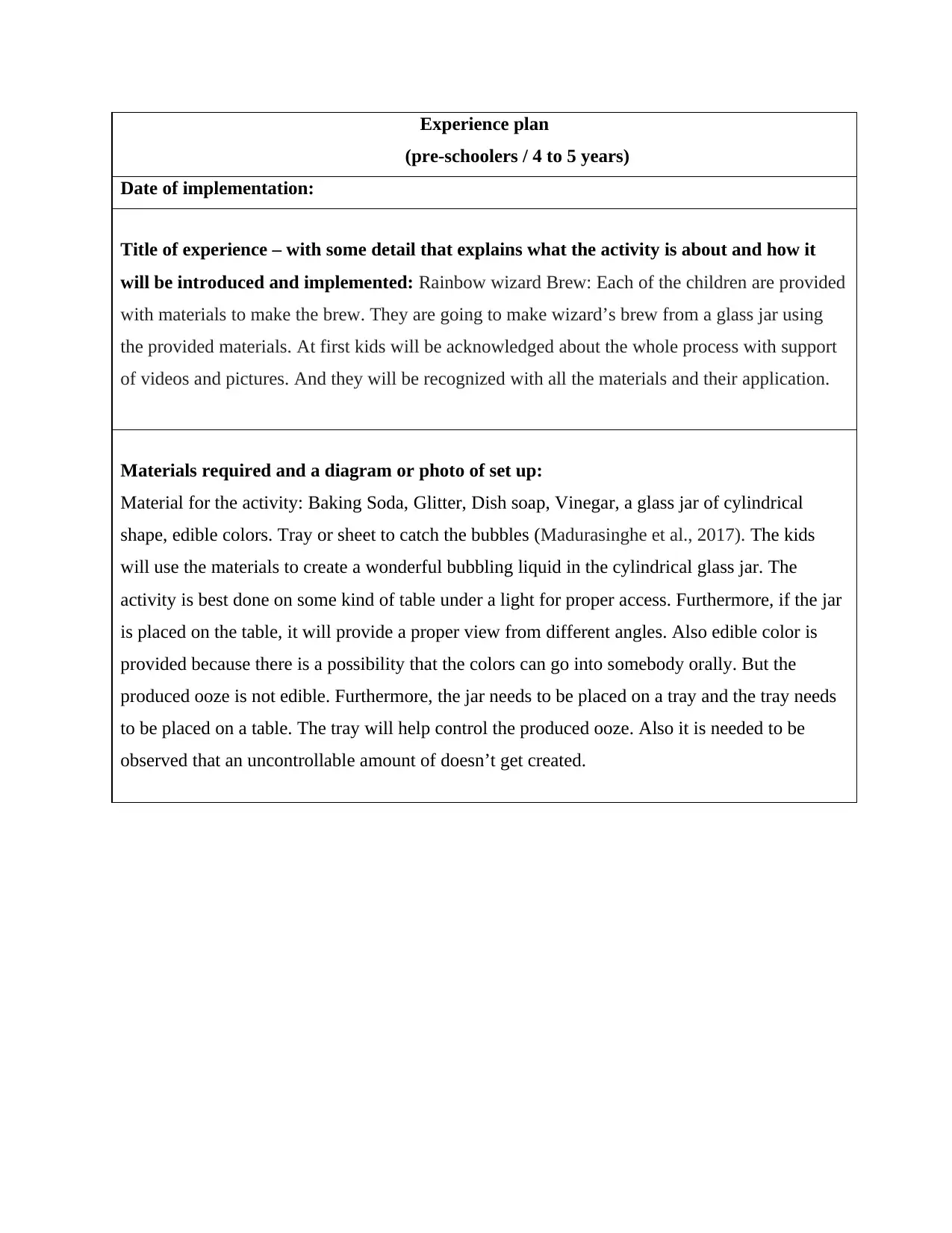
Experience plan
(pre-schoolers / 4 to 5 years)
Date of implementation:
Title of experience – with some detail that explains what the activity is about and how it
will be introduced and implemented: Rainbow wizard Brew: Each of the children are provided
with materials to make the brew. They are going to make wizard’s brew from a glass jar using
the provided materials. At first kids will be acknowledged about the whole process with support
of videos and pictures. And they will be recognized with all the materials and their application.
Materials required and a diagram or photo of set up:
Material for the activity: Baking Soda, Glitter, Dish soap, Vinegar, a glass jar of cylindrical
shape, edible colors. Tray or sheet to catch the bubbles (Madurasinghe et al., 2017). The kids
will use the materials to create a wonderful bubbling liquid in the cylindrical glass jar. The
activity is best done on some kind of table under a light for proper access. Furthermore, if the jar
is placed on the table, it will provide a proper view from different angles. Also edible color is
provided because there is a possibility that the colors can go into somebody orally. But the
produced ooze is not edible. Furthermore, the jar needs to be placed on a tray and the tray needs
to be placed on a table. The tray will help control the produced ooze. Also it is needed to be
observed that an uncontrollable amount of doesn’t get created.
(pre-schoolers / 4 to 5 years)
Date of implementation:
Title of experience – with some detail that explains what the activity is about and how it
will be introduced and implemented: Rainbow wizard Brew: Each of the children are provided
with materials to make the brew. They are going to make wizard’s brew from a glass jar using
the provided materials. At first kids will be acknowledged about the whole process with support
of videos and pictures. And they will be recognized with all the materials and their application.
Materials required and a diagram or photo of set up:
Material for the activity: Baking Soda, Glitter, Dish soap, Vinegar, a glass jar of cylindrical
shape, edible colors. Tray or sheet to catch the bubbles (Madurasinghe et al., 2017). The kids
will use the materials to create a wonderful bubbling liquid in the cylindrical glass jar. The
activity is best done on some kind of table under a light for proper access. Furthermore, if the jar
is placed on the table, it will provide a proper view from different angles. Also edible color is
provided because there is a possibility that the colors can go into somebody orally. But the
produced ooze is not edible. Furthermore, the jar needs to be placed on a tray and the tray needs
to be placed on a table. The tray will help control the produced ooze. Also it is needed to be
observed that an uncontrollable amount of doesn’t get created.
Paraphrase This Document
Need a fresh take? Get an instant paraphrase of this document with our AI Paraphraser
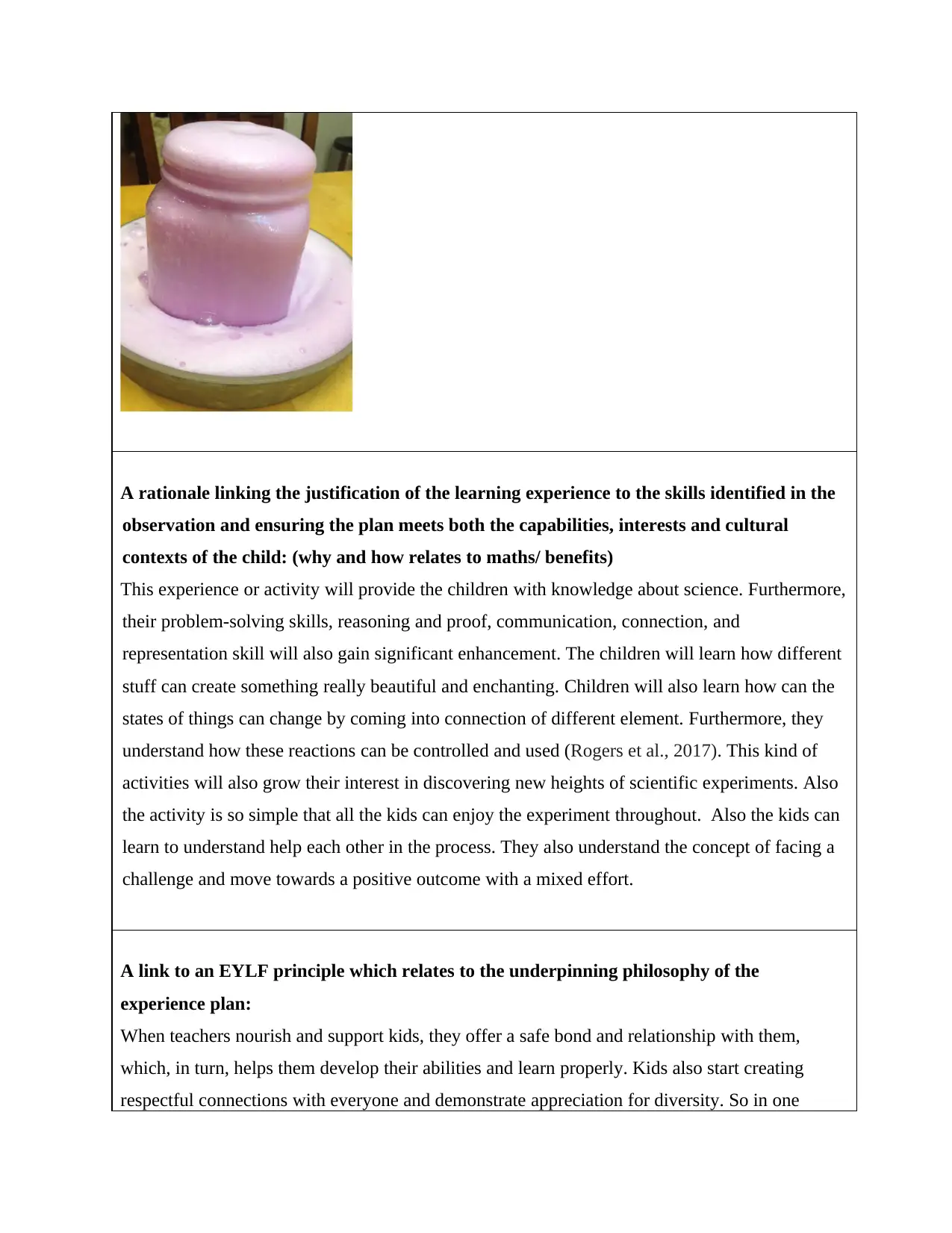
A rationale linking the justification of the learning experience to the skills identified in the
observation and ensuring the plan meets both the capabilities, interests and cultural
contexts of the child: (why and how relates to maths/ benefits)
This experience or activity will provide the children with knowledge about science. Furthermore,
their problem-solving skills, reasoning and proof, communication, connection, and
representation skill will also gain significant enhancement. The children will learn how different
stuff can create something really beautiful and enchanting. Children will also learn how can the
states of things can change by coming into connection of different element. Furthermore, they
understand how these reactions can be controlled and used (Rogers et al., 2017). This kind of
activities will also grow their interest in discovering new heights of scientific experiments. Also
the activity is so simple that all the kids can enjoy the experiment throughout. Also the kids can
learn to understand help each other in the process. They also understand the concept of facing a
challenge and move towards a positive outcome with a mixed effort.
A link to an EYLF principle which relates to the underpinning philosophy of the
experience plan:
When teachers nourish and support kids, they offer a safe bond and relationship with them,
which, in turn, helps them develop their abilities and learn properly. Kids also start creating
respectful connections with everyone and demonstrate appreciation for diversity. So in one
observation and ensuring the plan meets both the capabilities, interests and cultural
contexts of the child: (why and how relates to maths/ benefits)
This experience or activity will provide the children with knowledge about science. Furthermore,
their problem-solving skills, reasoning and proof, communication, connection, and
representation skill will also gain significant enhancement. The children will learn how different
stuff can create something really beautiful and enchanting. Children will also learn how can the
states of things can change by coming into connection of different element. Furthermore, they
understand how these reactions can be controlled and used (Rogers et al., 2017). This kind of
activities will also grow their interest in discovering new heights of scientific experiments. Also
the activity is so simple that all the kids can enjoy the experiment throughout. Also the kids can
learn to understand help each other in the process. They also understand the concept of facing a
challenge and move towards a positive outcome with a mixed effort.
A link to an EYLF principle which relates to the underpinning philosophy of the
experience plan:
When teachers nourish and support kids, they offer a safe bond and relationship with them,
which, in turn, helps them develop their abilities and learn properly. Kids also start creating
respectful connections with everyone and demonstrate appreciation for diversity. So in one
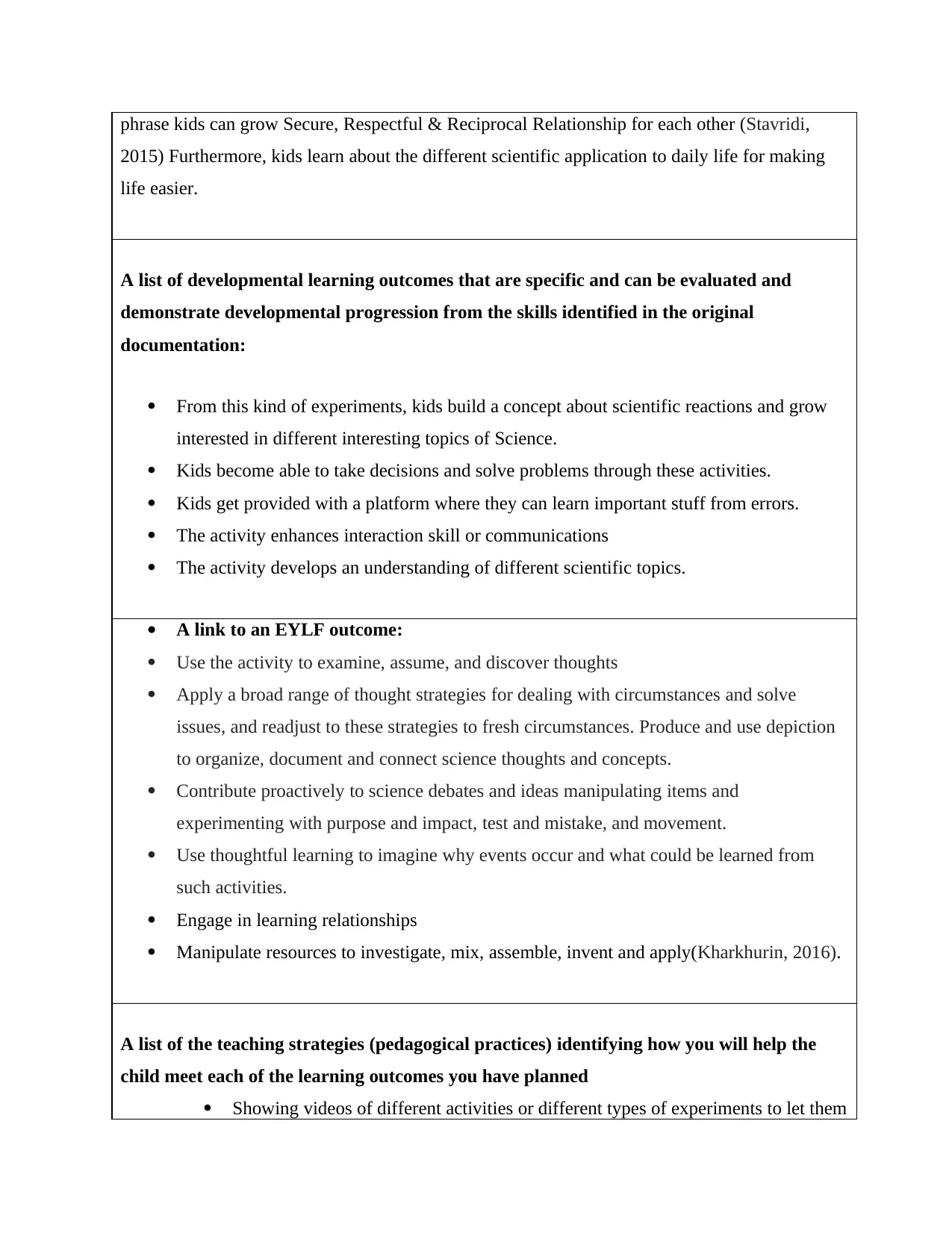
phrase kids can grow Secure, Respectful & Reciprocal Relationship for each other (Stavridi,
2015) Furthermore, kids learn about the different scientific application to daily life for making
life easier.
A list of developmental learning outcomes that are specific and can be evaluated and
demonstrate developmental progression from the skills identified in the original
documentation:
From this kind of experiments, kids build a concept about scientific reactions and grow
interested in different interesting topics of Science.
Kids become able to take decisions and solve problems through these activities.
Kids get provided with a platform where they can learn important stuff from errors.
The activity enhances interaction skill or communications
The activity develops an understanding of different scientific topics.
A link to an EYLF outcome:
Use the activity to examine, assume, and discover thoughts
Apply a broad range of thought strategies for dealing with circumstances and solve
issues, and readjust to these strategies to fresh circumstances. Produce and use depiction
to organize, document and connect science thoughts and concepts.
Contribute proactively to science debates and ideas manipulating items and
experimenting with purpose and impact, test and mistake, and movement.
Use thoughtful learning to imagine why events occur and what could be learned from
such activities.
Engage in learning relationships
Manipulate resources to investigate, mix, assemble, invent and apply(Kharkhurin, 2016).
A list of the teaching strategies (pedagogical practices) identifying how you will help the
child meet each of the learning outcomes you have planned
Showing videos of different activities or different types of experiments to let them
2015) Furthermore, kids learn about the different scientific application to daily life for making
life easier.
A list of developmental learning outcomes that are specific and can be evaluated and
demonstrate developmental progression from the skills identified in the original
documentation:
From this kind of experiments, kids build a concept about scientific reactions and grow
interested in different interesting topics of Science.
Kids become able to take decisions and solve problems through these activities.
Kids get provided with a platform where they can learn important stuff from errors.
The activity enhances interaction skill or communications
The activity develops an understanding of different scientific topics.
A link to an EYLF outcome:
Use the activity to examine, assume, and discover thoughts
Apply a broad range of thought strategies for dealing with circumstances and solve
issues, and readjust to these strategies to fresh circumstances. Produce and use depiction
to organize, document and connect science thoughts and concepts.
Contribute proactively to science debates and ideas manipulating items and
experimenting with purpose and impact, test and mistake, and movement.
Use thoughtful learning to imagine why events occur and what could be learned from
such activities.
Engage in learning relationships
Manipulate resources to investigate, mix, assemble, invent and apply(Kharkhurin, 2016).
A list of the teaching strategies (pedagogical practices) identifying how you will help the
child meet each of the learning outcomes you have planned
Showing videos of different activities or different types of experiments to let them
⊘ This is a preview!⊘
Do you want full access?
Subscribe today to unlock all pages.

Trusted by 1+ million students worldwide
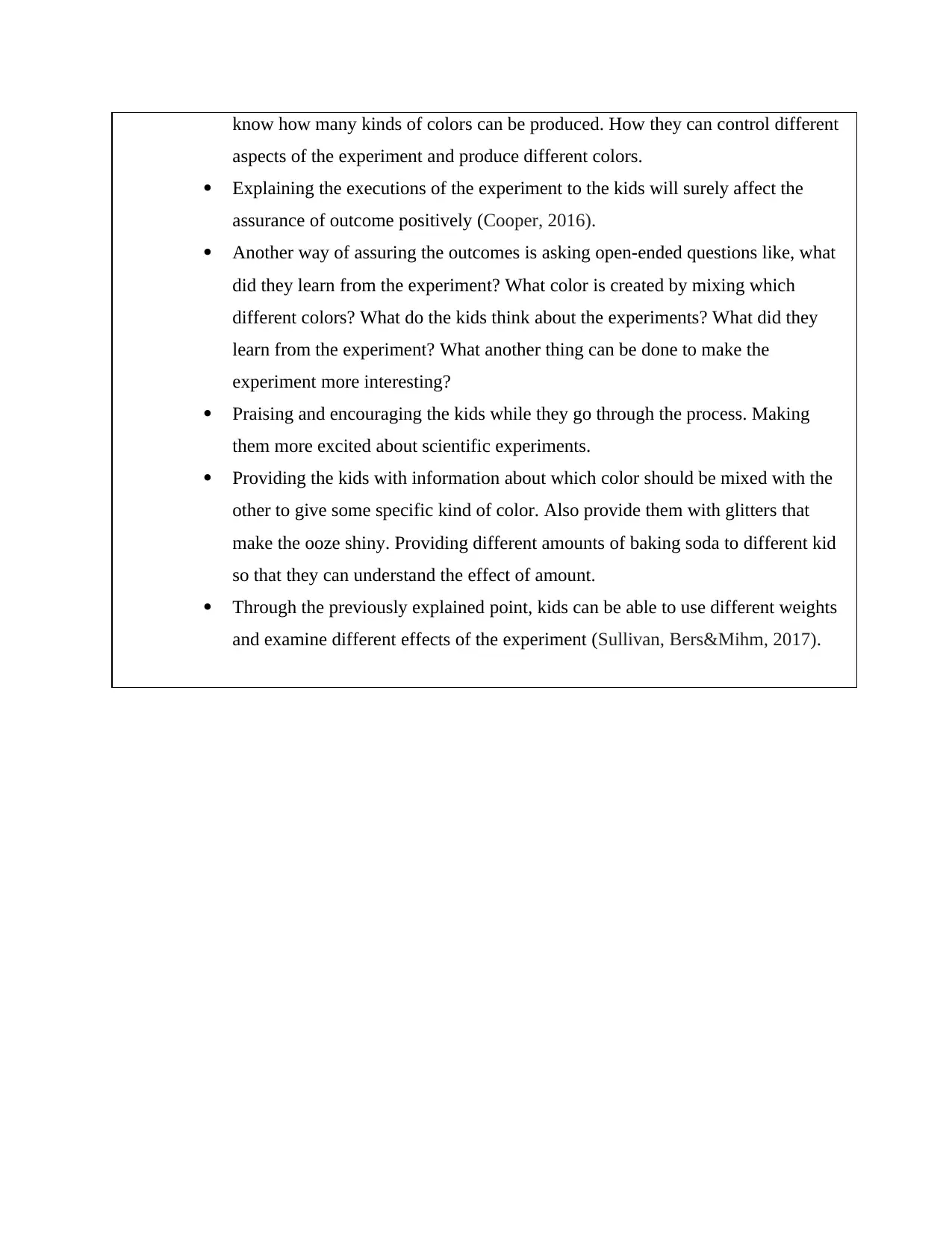
know how many kinds of colors can be produced. How they can control different
aspects of the experiment and produce different colors.
Explaining the executions of the experiment to the kids will surely affect the
assurance of outcome positively (Cooper, 2016).
Another way of assuring the outcomes is asking open-ended questions like, what
did they learn from the experiment? What color is created by mixing which
different colors? What do the kids think about the experiments? What did they
learn from the experiment? What another thing can be done to make the
experiment more interesting?
Praising and encouraging the kids while they go through the process. Making
them more excited about scientific experiments.
Providing the kids with information about which color should be mixed with the
other to give some specific kind of color. Also provide them with glitters that
make the ooze shiny. Providing different amounts of baking soda to different kid
so that they can understand the effect of amount.
Through the previously explained point, kids can be able to use different weights
and examine different effects of the experiment (Sullivan, Bers&Mihm, 2017).
aspects of the experiment and produce different colors.
Explaining the executions of the experiment to the kids will surely affect the
assurance of outcome positively (Cooper, 2016).
Another way of assuring the outcomes is asking open-ended questions like, what
did they learn from the experiment? What color is created by mixing which
different colors? What do the kids think about the experiments? What did they
learn from the experiment? What another thing can be done to make the
experiment more interesting?
Praising and encouraging the kids while they go through the process. Making
them more excited about scientific experiments.
Providing the kids with information about which color should be mixed with the
other to give some specific kind of color. Also provide them with glitters that
make the ooze shiny. Providing different amounts of baking soda to different kid
so that they can understand the effect of amount.
Through the previously explained point, kids can be able to use different weights
and examine different effects of the experiment (Sullivan, Bers&Mihm, 2017).
Paraphrase This Document
Need a fresh take? Get an instant paraphrase of this document with our AI Paraphraser
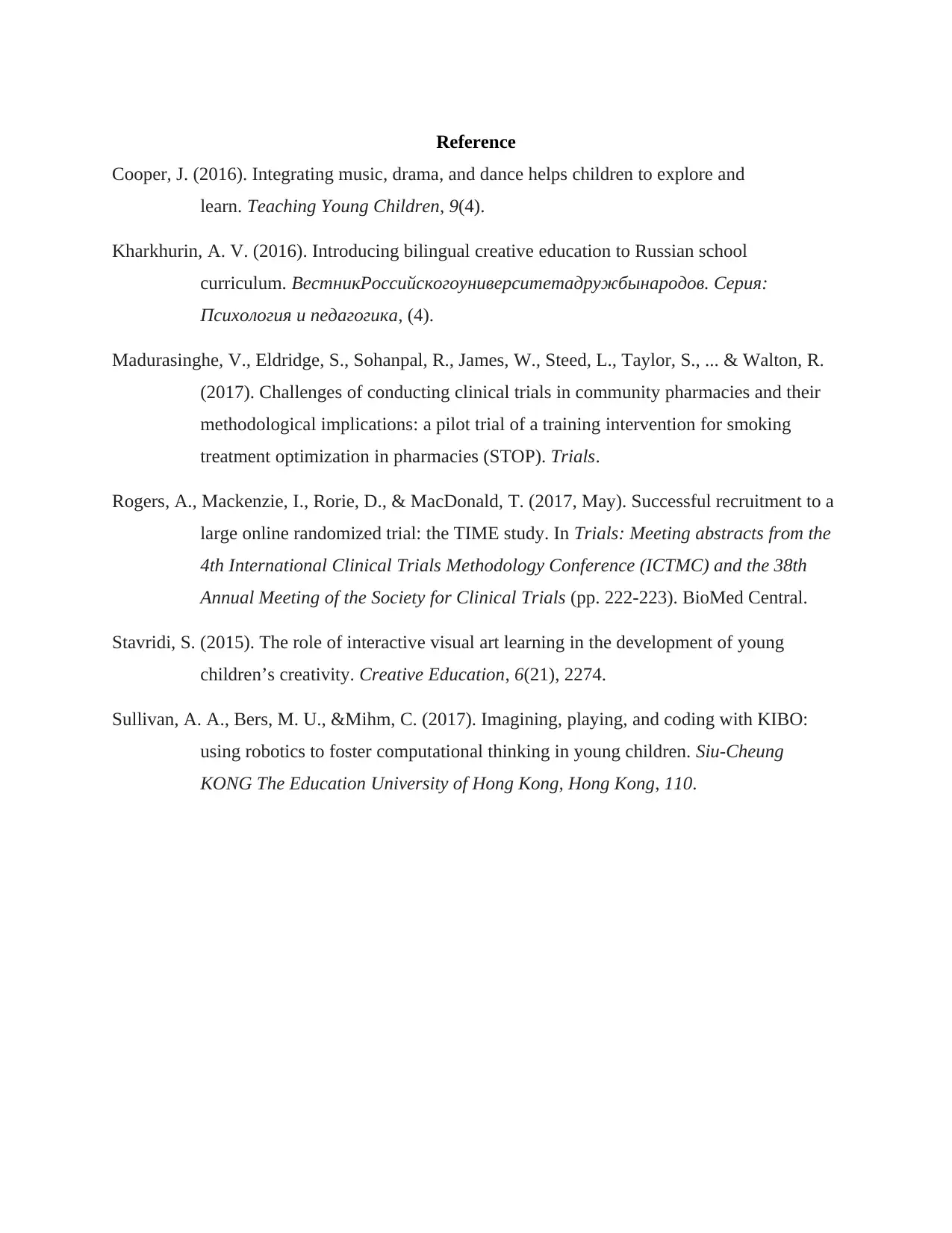
Reference
Cooper, J. (2016). Integrating music, drama, and dance helps children to explore and
learn. Teaching Young Children, 9(4).
Kharkhurin, A. V. (2016). Introducing bilingual creative education to Russian school
curriculum. ВестникРоссийскогоуниверситетадружбынародов. Серия:
Психология и педагогика, (4).
Madurasinghe, V., Eldridge, S., Sohanpal, R., James, W., Steed, L., Taylor, S., ... & Walton, R.
(2017). Challenges of conducting clinical trials in community pharmacies and their
methodological implications: a pilot trial of a training intervention for smoking
treatment optimization in pharmacies (STOP). Trials.
Rogers, A., Mackenzie, I., Rorie, D., & MacDonald, T. (2017, May). Successful recruitment to a
large online randomized trial: the TIME study. In Trials: Meeting abstracts from the
4th International Clinical Trials Methodology Conference (ICTMC) and the 38th
Annual Meeting of the Society for Clinical Trials (pp. 222-223). BioMed Central.
Stavridi, S. (2015). The role of interactive visual art learning in the development of young
children’s creativity. Creative Education, 6(21), 2274.
Sullivan, A. A., Bers, M. U., &Mihm, C. (2017). Imagining, playing, and coding with KIBO:
using robotics to foster computational thinking in young children. Siu-Cheung
KONG The Education University of Hong Kong, Hong Kong, 110.
Cooper, J. (2016). Integrating music, drama, and dance helps children to explore and
learn. Teaching Young Children, 9(4).
Kharkhurin, A. V. (2016). Introducing bilingual creative education to Russian school
curriculum. ВестникРоссийскогоуниверситетадружбынародов. Серия:
Психология и педагогика, (4).
Madurasinghe, V., Eldridge, S., Sohanpal, R., James, W., Steed, L., Taylor, S., ... & Walton, R.
(2017). Challenges of conducting clinical trials in community pharmacies and their
methodological implications: a pilot trial of a training intervention for smoking
treatment optimization in pharmacies (STOP). Trials.
Rogers, A., Mackenzie, I., Rorie, D., & MacDonald, T. (2017, May). Successful recruitment to a
large online randomized trial: the TIME study. In Trials: Meeting abstracts from the
4th International Clinical Trials Methodology Conference (ICTMC) and the 38th
Annual Meeting of the Society for Clinical Trials (pp. 222-223). BioMed Central.
Stavridi, S. (2015). The role of interactive visual art learning in the development of young
children’s creativity. Creative Education, 6(21), 2274.
Sullivan, A. A., Bers, M. U., &Mihm, C. (2017). Imagining, playing, and coding with KIBO:
using robotics to foster computational thinking in young children. Siu-Cheung
KONG The Education University of Hong Kong, Hong Kong, 110.
1 out of 5
Related Documents
Your All-in-One AI-Powered Toolkit for Academic Success.
+13062052269
info@desklib.com
Available 24*7 on WhatsApp / Email
![[object Object]](/_next/static/media/star-bottom.7253800d.svg)
Unlock your academic potential
Copyright © 2020–2025 A2Z Services. All Rights Reserved. Developed and managed by ZUCOL.




